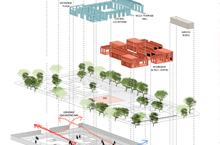
SANSKRITAALAYA
Community centre at Nizamabad, Azamgarh, Uttar Pradesh
Category: Community Facility

A small community of potter’s who practice black pottery reside at Nizamabad, a small town in Azamgarh District situated on the banks of river Tamsa. Though, very skillful, they are giving up their traditional craft as their products do not fetch good price because of lack of exposure, amenities, changing traditions and impact of modernity that make them realize they cannot make a living out of it. This in turn has brought the languishing craft of the potters on the verge of extinction. This project endeavours to revive the traditional art by means of architecture.
The Team

ARCHITECT
ANKITA GOEL
Consultant Architect,
XXI- ARCHITECTURE,
NEW DELHI

ARCHITECT
SHOURYA SHARMA
Consultant Architect,
XXI- ARCHITECTURE,
NEW DELHI

ARCHITECT
DUSHYANT SINGH
Consultant Architect,
XXI- ARCHITECTURE,
NEW DELHI

ARCHITECT
NAZISH ABID
Founder,
XXI- ARCHITECTURE,
NEW DELHI

ARCHITECT
SHRUTI SETHI
Consultant Architect,
XXI- ARCHITECTURE,
NEW DELHI

ARCHITECT
PRIYANSH SHARMA
Consultant Architect,
XXI- ARCHITECTURE,
NEW DELHI
The Challenge

There is a need for a self-sustaining institute to extend and bridge the social spheres of the neighbourhood and uplift the quality of life of the craftsmen’s to improve their quality of living. There is a need to provide the craftsmen with the basic amenities at reasonable price while having training centres to skill craftpersons and an area to exhibit their products.
The Solution

This institutes’ architecture would be culturally oriented and would encourage interested and skilled individuals to learn the entire art of traditional black pottery by amalgamating latest technology with traditional practice. The solution works on the following criteria:
1. Envision Social upliftment
2. Create - New Economic value
3. Building - Integrated development
4. Reshaping the waste
Expected Impact

The program thereby takes care of reviving back the independent working environments and the lost work culture of the village. The project is realistic and public oriented. It will improve the living standards of the people in the villages contribute in GDP of the country.
